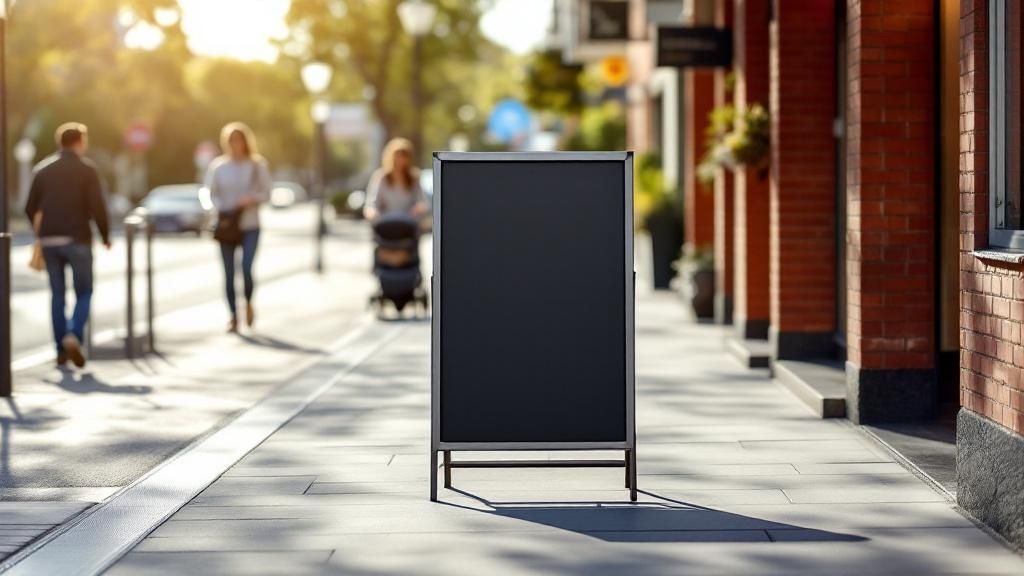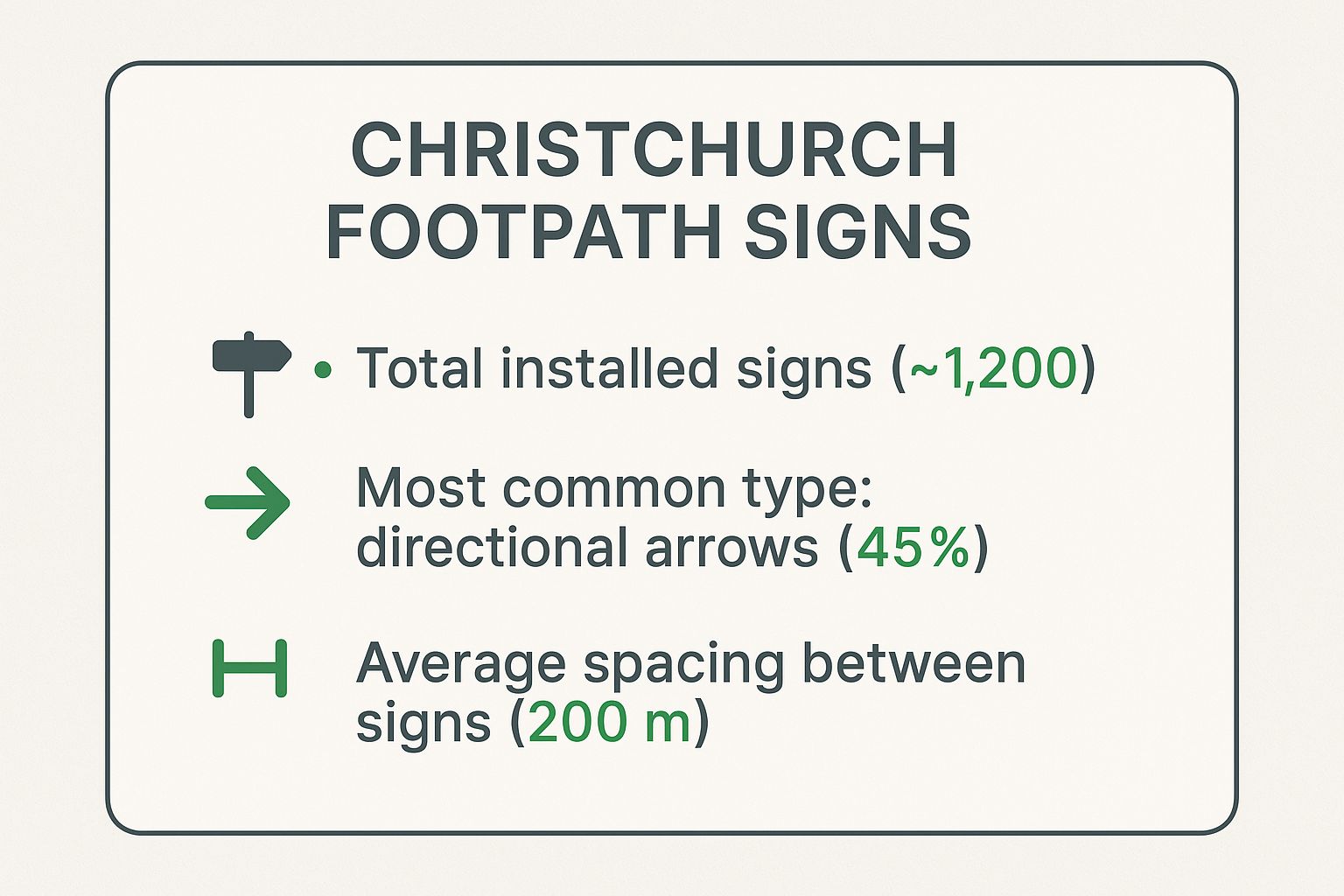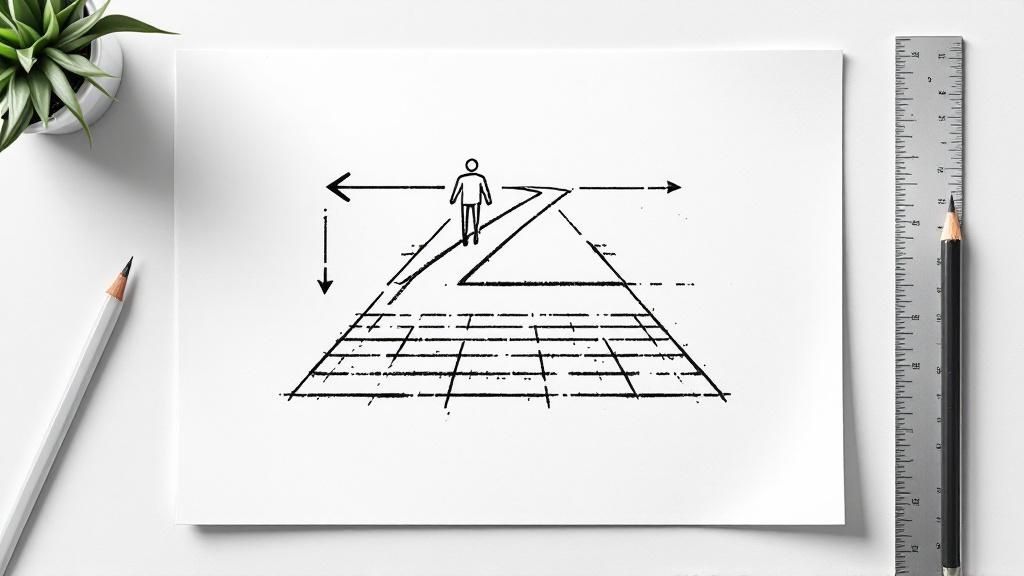Your cart is currently empty.

Picture this: every day, hundreds of potential customers walk right past your business. So, how do you get them to stop, look, and step inside? The answer is often simpler than you think: a well-designed, strategically placed footpath sign. It’s your silent salesperson, working tirelessly to turn passers-by into paying customers.
How Footpath Signs Can Transform Your Business
Think of the bustling streets of Christchurch as a river of potential customers flowing by. Your business is on the riverbank, but you need a way to convince people to pull over. This is where a great footpath sign comes in—it's your most effective, low-cost marketing tool, acting as a friendly handshake that starts a conversation.
A classic A-frame, a sleek swinging sign, or a modern blade sign does more than just announce your name. It tells a story. It sparks curiosity. It creates an immediate, personal connection by highlighting a daily special, announcing a sale, or simply offering a warm welcome. It’s a physical interruption in a person's digital-first day, a powerful way to cut through the noise.
The Power of a Silent Salesperson
Unlike a digital ad that someone can easily scroll past, a physical sign commands attention in the real world. It’s a tangible invitation. While online strategies are vital for businesses like restaurants to boost local foot traffic, a well-designed footpath sign achieves the very same goal on the ground. It's all about being seen at that critical moment of decision.
A great sign doesn't just inform; it persuades. It's the final, crucial link between someone walking down the street and someone walking through your door, often ready to make a purchase.
The visual below breaks down some key insights into how businesses are using footpath signs across Christchurch.

As you can see, directional signs are incredibly popular, which makes perfect sense in a busy city centre. To help you figure out what might work for your own business, let's look at the most common options.
Quick Guide to Common Footpath Sign Types
Choosing the right sign can feel overwhelming, but it really comes down to your location, your brand, and what you want to say. This table breaks down the most popular choices to give you a head start.
| Sign Type | Best For | Key Feature | Material |
|---|---|---|---|
| A-Frame Sign | Cafés, retail, daily specials | Classic, stable, and highly visible from both directions. | Metal, Wood, Plastic |
| Swing Sign | Windy locations, modern storefronts | Gentle movement attracts the eye; often has a weighted base. | Metal, PVC |
| Blade Sign | Businesses with narrow frontage | Protrudes from the building, visible from a distance. | Aluminium, Wood |
| Chalkboard Sign | Hospitality, businesses with changing offers | Easily customisable, offers a rustic and personal touch. | Wood Frame, Slate |
Each of these has its own strengths. An A-frame is a reliable workhorse for a cafe advertising its coffee special, while a blade sign can help a boutique stand out on a crowded street. The key is to match the sign's function to your business's specific needs.
Mastering Christchurch Footpath Sign Rules
Navigating council regulations can feel like a real headache, but when it comes to footpath signs in Christchurch, the rules are actually quite straightforward. At their heart, they’re all about one thing: keeping our shared public spaces safe, clear, and accessible for absolutely everyone.
Think of it this way: getting the rules right isn’t just about ticking boxes for the council. It’s about being a good neighbour and a responsible part of the community. A well-placed sign means there’s plenty of room for parents with prams, people using wheelchairs, and anyone just out for a stroll. It keeps the city’s footpaths welcoming. Let's break down what the official Christchurch City Council bylaws mean for your business in plain English.
The Core Placement Rule
This is the big one, the golden rule of footpath signs. Your sign must be placed right up against the front of your building. No exceptions. This leaves the main stretch of the pavement completely clear for people to walk. Just picture someone trying to navigate past with a double buggy or a mobility scooter; they need that clear, predictable path to move safely.
The Christchurch City Council is very clear on this: there must be a minimum clear footpath width of 1.8 metres at all times. Tucking your sign against your shopfront is the easiest way to make sure you’re meeting this crucial requirement.
Placing your sign here is non-negotiable. It stops signs from becoming dangerous trip hazards out in the open and keeps the main flow of foot traffic moving smoothly.
Understanding Size and Dimension Limits
To stop our streets from becoming a cluttered mess, the council also has specific limits on how big your footpath signs can be. It makes sense—oversized signs can easily block sightlines for drivers pulling out of parks, not to mention making the footpath feel crowded and chaotic.
The limits are simple and easy to remember:
- Maximum Height: Your sign can't be taller than 1 metre from the ground.
- Maximum Width: It can't be wider than 700 millimetres (or 0.7 metres).
These dimensions are designed to keep the streetscape looking tidy and, most importantly, safe. A sign that sticks to these measurements is still plenty big enough to get noticed without turning into a public nuisance. Before you order any footpath signs for your Christchurch business, it's a good idea to double-check the product specs against these numbers.
Timing is Everything: Display Hours
Remember, footpath signs are temporary advertising, not permanent street furniture. That means they should only be out on the pavement while your business is actually open. This rule helps keep the footpaths clear outside of trading hours, making things easier for street cleaning crews and safer for anyone walking around at night.
It’s best to build it right into your daily routine:
- Morning Setup: Put your sign out just as you’re opening up for the day.
- Evening Pack-down: Bring it back inside right after you lock the doors.
Making this a standard part of your opening and closing checklist means you'll never have to worry about being non-compliant. Plus, it protects your sign from being damaged or stolen overnight.
Essential Rules at a Glance
If you don't have time to wade through the full bylaw document, don't worry. Here’s a quick summary of the key rules every Christchurch business owner needs to have down pat.
| Regulation Category | Key Requirement | Why It Matters |
|---|---|---|
| Placement | Must be placed flat against your building's wall. | Guarantees a 1.8m minimum clear path for everyone, preventing obstructions and trip hazards. |
| Dimensions | Cannot exceed 1m in height or 700mm in width. | Stops signs from blocking visibility for drivers and pedestrians or creating visual clutter. |
| Display Hours | Only permitted during your business's operating hours. | Keeps footpaths clear overnight for safety, cleaning crews, and general accessibility. |
| Sign Condition | Must be kept in good, clean, and stable condition. | A dodgy, broken sign is a safety risk and doesn't exactly send a great message about your business. |
Following these guidelines for your footpath signs in Christchurch is refreshingly simple. It shows you respect your local community and ensures your marketing efforts are both effective and responsible. When you make compliance a simple part of your daily habits, you can put your sign out with confidence and let it do what it’s supposed to do: bring great customers through your door.
Designing Signs That Actually Stop People
Getting a sign that meets council rules is one thing, but designing one that actually brings new customers through your door? That's a whole different ball game. It’s time to think beyond just slapping your name and logo on a board. We need to get into the nitty-gritty of what makes a message grab attention and turn a passerby into a paying customer.

Think about it: the average person walking down a busy Christchurch street will only give your sign a fleeting glance. A few seconds, max. In that tiny window, your design has to do all the heavy lifting. It needs to be seen, understood, and be compelling enough to make someone stop, turn, and walk into your shop.
This isn’t about guesswork; it’s about smart design. The human eye is wired to notice certain things. If you know what they are, you can create a sign that’s practically impossible to ignore.
The Foundation of a Great Sign Design
Your sign is essentially a mini-billboard. Its main job is to get a message across almost instantly. To pull that off, you need to nail three crucial elements: colour, contrast, and clear typography.
Colour and Contrast
Bright, bold colours are your best friend—they pop against the grey pavement and brick buildings of a city street. But colour on its own isn't a silver bullet. You need strong contrast between your background and your text. This is what makes your sign readable from a distance.
Some combinations are classics for a reason—they just work:
- Black text on a white or yellow background is one of the most legible options out there.
- White text on a black or dark blue background creates a sharp, modern feel.
- Steer clear of low-contrast pairings like light grey on white or yellow on orange. From more than a metre away, they just turn into a blurry mess.
Clear Typography
Fancy, decorative fonts might look lovely on a wedding invitation, but they’re a disaster for a footpath sign. Your goal here is instant readability. Stick to bold, clean, and simple fonts.
A passerby should be able to read your entire message in under three seconds. If they have to squint or struggle to decipher a swirly script, you’ve already lost them. Simplicity always wins.
Crafting a Message That Converts
So, you've got the visual basics sorted. What should your sign actually say? A sign that just reads "SALE" is better than nothing, but it's a huge missed opportunity. Your copy needs to do more. It should spark urgency, ask a question, or make a promise that’s too good to pass up.
Try one of these angles:
- Create Urgency: "Last Day for 50% Off Jackets!"
- Ask a Question: "Tired of Boring Lunches?"
- Make a Promise: "The Best Coffee You'll Have All Day."
- Be Witty or Humorous: "Come in and try the worst coffee one lady on TripAdvisor ever had in her life."
These kinds of messages work because they engage the brain. They create a little emotional hook that’s far more powerful than a bland statement. When you're planning your footpath signs in Christchurch, it’s a great idea to test out a few different messages to see what really clicks with the locals.
To really bring it all together, tapping into professional graphic design services can be a game-changer. An expert knows how to take your brand’s personality and turn it into a visual that literally stops people in their tracks, making sure your sign is a smart investment that pays for itself.
Choosing Materials That Can Handle Christchurch Weather

We all know how Christchurch weather can turn on a dime. One minute it's perfectly calm and sunny, the next a roaring nor’wester is testing anything not nailed down. A flimsy sign that topples over in the first gust or fades after one summer doesn't just look bad—it reflects poorly on your business.
Getting the right material for your sign is more than just a practical decision; it’s an investment in your brand’s reputation. You need your sign to look sharp and professional every single day, not just for the first week. That means picking something that can truly stand up to our city’s wind, rain, and intense UV rays.
So, let's walk through the most common materials for footpath signs in Christchurch. This will help you make a smart choice that looks great for years to come.
Comparing Common Sign Materials
The material you go with will directly affect your sign's weight, lifespan, look, and of course, its price. There's no single "best" material for everyone—it really depends on where you're located and what your budget is. A business on a windy CBD corner will need a heavy, stable sign, while a shop tucked away in a quiet suburban laneway can get by with something lighter.
Here’s a practical look at the most popular options:
- Metal (Aluminium or Steel): These are the heavyweights, and for good reason. They offer fantastic stability in windy spots and give off a vibe of quality and permanence. Aluminium is the lighter of the two and won't rust, while classic steel A-frames are incredibly tough but can be a bit of a mission to lug inside each night.
- Heavy-Duty Plastic (PVC): A brilliant all-rounder. PVC is tough, completely weatherproof, and much lighter than metal. Many of the newer swing signs you see have a hollow plastic base that can be filled with water or sand, giving you the best of both worlds: stability when you need it and portability when you don't.
- Wood: Nothing beats the classic, rustic charm of a wooden sign. It’s the perfect look for cafés, artisan shops, or any business going for a warm, natural feel. The catch? They need to be properly sealed and maintained to keep moisture and rot at bay.
- Corflute: This is your go-to for short-term or budget-friendly needs, like promoting a one-off event. While it’s incredibly lightweight and easy to print on, corflute simply isn’t built for the long haul. The wind can damage it easily, and the sun will cause it to fade.
Think of choosing your material as future-proofing your investment. Spending a bit more now on a sturdy metal or high-grade plastic sign will almost certainly save you the cost and hassle of replacing a cheap, weather-beaten one in a few months' time.
Matching the Display Type to Your Message
Beyond the frame itself, you need to think about how you'll get your message across. Is your branding set in stone, or do you need to advertise daily specials? The surface of your sign is just as crucial as the structure holding it up.
Permanent vs. Changeable Displays
This choice comes down to your business model. A law firm will want a permanent, professionally printed sign with its name and services. A cafe, however, absolutely needs the flexibility to scrawl up the daily soup special or a happy hour deal.
- Permanent Printed Panels: These are perfect for core branding that won't change. We're talking high-quality digital prints that are laminated to protect against UV rays and water, ensuring your logo stays crisp and vibrant for years.
- Chalkboard or Whiteboard Surfaces: An essential for hospitality and retail. They let you get creative and update your message in seconds with liquid chalk pens or markers.
- Interchangeable Inserts: Some A-frames are designed so you can slide printed panels (often corflute or PVC) in and out. This offers a great middle ground—a professional printed sign that you can easily swap out for different promotions, seasons, or events.
At the end of the day, the best footpath signs Christchurch businesses use are the ones that perfectly suit their environment, brand, and day-to-day needs. By thinking carefully about both the frame's material and the display surface, you can be sure your sign will remain a hardworking and effective marketing tool, no matter what the weather throws at it.
Your Role in Christchurch's Accessible City Vision
Your footpath sign is so much more than an advert. It's a physical object sitting in a shared public space, making it a real piece of Christchurch’s urban landscape. Following the council rules isn't just about ticking a box or avoiding a fine; it’s about playing your part in the city’s mission to be accessible for every single person.
This commitment really came into focus after the devastating 2011 earthquake. The rebuild was a rare chance to create a more inclusive, thoughtfully designed city from the ground up. By using your sign responsibly, you're being a good neighbour and contributing to a safer city for all of us.
A City Rebuilt with Accessibility in Mind
Christchurch has long been a leader in New Zealand for its pedestrian-friendly policies. Back in 2013, the city launched its 'An Accessible City' recovery plan. This wasn't just about meeting legal minimums; it was a strategy to actively improve accessibility. The plan was shaped by the hard reality that thousands of Kiwis live with low vision or mobility challenges, and for them, a clear, unobstructed footpath is vital for their safety and independence. You can read more about Christchurch's journey toward accessibility on inclusivecitymaker.com.
Understanding this background changes how we should look at compliance. Following the rules for footpath signs in Christchurch becomes a positive, community-minded action. It’s a small but meaningful way to contribute to a city that values every one of its residents.
When you place your sign correctly against your building, you are doing more than just obeying a bylaw. You are personally helping to keep the footpath clear for a parent with a pram, a person in a wheelchair, or someone using a white cane to navigate.
Reframing Compliance as a Positive Contribution
It’s easy to get bogged down and see regulations as just another hurdle. But these rules are here to protect the very community your business serves. Each correctly placed sign helps build a city where people feel safe, welcome, and able to move around freely.
Thinking about it this way connects your daily business operations to a much larger, shared civic goal. Your thoughtful sign placement has a direct, positive impact on the quality of life for so many people in Christchurch.
Here’s how your actions contribute to the accessible city vision:
- Promoting Safety: A correctly placed sign removes a major trip hazard, preventing accidents for everyone, especially those with mobility or vision impairments.
- Ensuring Equal Access: You guarantee the footpath stays wide enough for wheelchairs, mobility scooters, and prams to get through without a struggle.
- Building Community Trust: When businesses show they care about public space and safety, it builds goodwill and strengthens their relationship with the local community.
- Upholding Christchurch’s Values: You actively participate in the city's commitment to being a welcoming and inclusive place for residents and tourists alike.
Ultimately, your sign is a representative of your brand out in the public eye. By placing it with care and consideration, you’re showing that your business is a responsible and valued member of the Christchurch community, one that’s committed to making our city better for everyone.
Keeping Your Signage Safe and Effective
Your footpath sign is often the first handshake you have with a potential customer. A bright, clean sign speaks volumes about the care you put into your business. On the flip side, a grimy, faded, or wobbly sign can send completely the wrong message before anyone even steps through your door.
Think of your sign not just as a one-off purchase, but as a hard-working asset that needs a little bit of ongoing attention to stay sharp.

The easiest way to approach this is to make sign care part of your daily opening and closing routine. A quick wipe-down in the morning clears away any dust or grime that's settled overnight, making sure your message is always crisp and professional. It’s a simple habit that protects your investment and keeps your business looking its best.
Building a Simple Maintenance Routine
Consistency is everything when it comes to getting the most out of your sign. A little bit of care each day goes a long way in preventing bigger, more costly problems from developing. Following a simple checklist will help ensure your sign remains a safe, effective marketing tool for years to come.
Here's a solid routine to follow:
- Daily Clean: Give your sign a quick wipe with a damp cloth to get rid of dust, dirt, or water spots. If you're using a chalkboard, make sure yesterday's special is completely gone so you have a clean slate for today.
- Weekly Inspection: Take a minute to look over the whole sign—the hinges, the frame, and the base. Are there any loose screws? Any cracks appearing? Any spots of rust that need to be addressed?
- Weather Awareness: Keep an eye on the forecast. A classic Canterbury nor'wester can pack a punch, and strong winds can turn even the sturdiest A-frame into a safety hazard. When the weather turns nasty, it's always best to bring your sign inside.
A well-cared-for sign is a safe sign. Regular checks ensure it remains stable and doesn't pose a risk to the public, protecting both pedestrians and your business from potential liability issues.
Protecting Your Asset Overnight and Beyond
Your duty of care doesn't stop when you lock the doors. Bringing your sign inside overnight is non-negotiable. This simple step is your best defence against theft, vandalism, and unnecessary wear and tear from the elements. Find a secure, dry spot to store it.
This practice isn't just about protecting your investment; it's also about being a good neighbour and respecting our city’s shared spaces. Christchurch City Council manages a huge network of pedestrian infrastructure—around 2,250 kilometres of footpaths, in fact. As our city grows, looking after this infrastructure is crucial for everyone's safety and accessibility. Your well-managed sign is a small but important part of that.
For a deeper dive into the city's approach, you can check out the council’s Activity Management Plan for Roads and Footpaths.
By properly maintaining and storing your footpath signs in Christchurch, you're ensuring they remain valuable assets for your business. It shows you hold high standards and respect the community you operate in.
Common Questions About Footpath Signs
Even after getting your head around the rules and design basics, a few questions often pop up. Let's tackle some of the most common queries we hear from business owners about using footpath signs in Christchurch. Think of this as your go-to FAQ.
How Much Does a Good Footpath Sign Cost?
Honestly, the price can swing quite a bit depending on what you're after. The cost is all tied to the material, size, and how much custom work is involved. For a straightforward, entry-level A-frame, you might be looking at around $150. They're a simple and effective way to get your message out there.
If you’re aiming for something more permanent and polished, like a custom-designed sign made from solid metal or a beautifully finished timber, the investment is typically in the $300 to $500+ range. It’s best to see this as a long-term marketing tool, not just an expense. A quality sign that’s built to last can pull in customers for years, making it a brilliant return on investment.
Think of it this way: if your sign brings in just a handful of new customers, it has likely already paid for itself. Investing in quality from the start means you won't be replacing a flimsy, broken sign in six months.
What Happens If Someone Trips Over My Sign?
This is a big one. You could absolutely be held liable if someone trips and injures themselves on your sign. That’s precisely why sticking to the council's placement rules isn't just a suggestion—it's essential.
Always, always make sure your sign is placed flat against your shop frontage. This leaves the mandatory 1.8 metres of clear footpath for people to walk past safely. Getting this positioning right is your best defence against accidents and any potential liability claims. It's also a smart move to double-check that your public liability insurance covers this specific scenario.
Are There Restricted Areas for Signs in the CBD?
Yes, there are. While footpath signs in Christchurch are generally allowed in most commercial areas, some high-traffic pedestrian zones have much tighter restrictions.
This usually includes places like:
- The main retail precinct.
- Pedestrian-focused spots like New Regent Street.
- Busy public spaces such as Cathedral Square.
In these specific zones, signage might be confined to designated areas or come with extra rules. These regulations can be updated, so it’s crucial to check the latest Christchurch City Council bylaws for your exact location before putting a sign out. Better to be safe than sorry.
At SONI DESIGN, we specialise in crafting eye-catching, durable, and fully compliant footpath signs that make your Christchurch business stand out. From design to delivery, we make your vision come alive. Let's create something extraordinary together—explore our signage solutions at https://www.sonidesign.co.nz.
Leave a Comment
Stay home & get your daily
needs from our shop
Start You'r Daily Shopping with Nest Mart
Best prices & offers
Orders $50 or more
Free delivery
24/7 amazing services
Great daily deal
When you sign up
Wide assortment
Mega Discounts
Easy returns
Within 30 days
